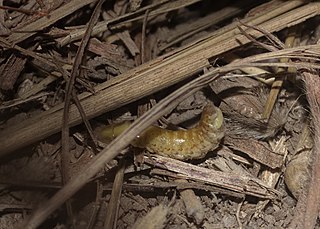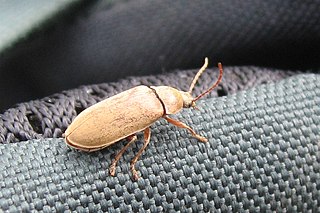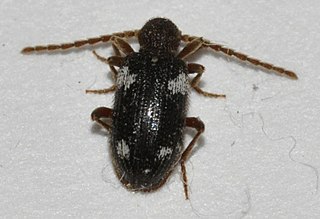
The sap beetles, also known as Nitidulidae, are a family of beetles.

The insects of the beetle family Chrysomelidae are commonly known as leaf beetles, and include over 37,000 species in more than 2,500 genera, making up one of the largest and most commonly encountered of all beetle families. Numerous subfamilies are recognized, but the precise taxonomy and systematics are likely to change with ongoing research.

The longhorn beetles (Cerambycidae), also known as long-horned or longicorns, are a large family of beetles, with over 35,000 species described. Most species are characterized by extremely long antennae, which are often as long as or longer than the beetle's body. In various members of the family, however, the antennae are quite short and such species can be difficult to distinguish from related beetle families such as the Chrysomelidae. The scientific name of this beetle family goes back to a figure from Greek mythology: after an argument with nymphs, the shepherd Cerambus was transformed into a large beetle with horns.

Polyphaga is the largest and most diverse suborder of beetles. It comprises 144 families in 16 superfamilies, and displays an enormous variety of specialization and adaptation, with over 350,000 described species, or approximately 90% of the beetle species so far discovered.

Lutrochidae is a family of water beetles with a single genus Lutrochus sometimes known as "travertine beetles". There are around 21 species native to the Americas from the southern United States to Brazil.

Scarabaeoidea is a superfamily of beetles, the only subgroup of the infraorder Scarabaeiformia. Around 35,000 species are placed in this superfamily and some 200 new species are described each year. Its constituent families are also undergoing revision presently, and the family list below is only preliminary.

The Chrysomeloidea are an enormous superfamily of beetles, with tens of thousands of species. The largest families are Cerambycidae, long-horned beetles, with more than 35,000 species, and Chrysomelidae, leaf beetles, with more than 13,000 species.

Blister beetles are beetles of the family Meloidae, so called for their defensive secretion of a blistering agent, cantharidin. About 7,500 species are known worldwide. Many are conspicuous and some are aposematically colored, announcing their toxicity to would-be predators.

The Rhagophthalmidae are a family of beetles within the superfamily Elateroidea. Members of this beetle family have bioluminescent organs on the larvae, and sometimes adults, and are closely related to the Phengodidae, though historically they have been often treated as a subfamily of Lampyridae, or as related to that family. Some recent evidence suggested that they were the sister group to the Phengodidae, and somewhat distantly related to Lampyridae, whose sister taxon was Cantharidae, but more reliable genome-based phylogenetics placed as the sister group to the Lampyridae.

The family Scraptiidae is a small group of tenebrionoid beetles sometimes called false flower beetles. There are about 400 species in 30 genera with a world-wide distribution. The adults are found on flowers, sometimes in large numbers, but are also found on foliage. The larvae are typically found under the bark of dead trees. The oldest fossils of the group date to the Eocene.

Dascilloidea is a superfamily of polyphagan beetles, comprising two families: Dascillidae and Rhipiceridae.

The Orsodacnidae are a small family of leaf beetles, previously included as a subfamily within the Chrysomelidae. It is the smallest of the Chrysomeloid families in North America; Oxypeltidae is smaller, with only three species in South America. A fossil species of Aulacoscelis is known from the Early Cretaceous (Aptian-Albian) Santana Group of Brazil.

Histeroidea is a superfamily of beetles in the infraorder Staphyliniformia.

Glaphyridae is a family of beetles, commonly known as bumble bee scarab beetles. There are eight extant genera with about 80 species distributed worldwide and two extinct genera described from the Aptian aged Yixian Formation of China. There are cases of flower-beetle interactions, in the southeast Mediterranean region between red bowl-shaped flowers and Glaphyridae beetles.

Spider beetles make up the subfamily Ptininae, in the family Ptinidae. There are approximately 70 genera and 600 species in the subfamily, with about 12 genera and 70 species in North America north of Mexico.

The Crowsoniellidae are a monotypic family of beetles, in the suborder Archostemata. So far, only a single species, Crowsoniella relicta, has been attributed to this family. Known only from three male specimens collected in 1973 in Italy by Roberto Pace. In a degraded pasture, the beetles were found among the roots of a large hawthorn tree, in deep calcareous soil. No other specimens have been found since.

Phycosecidae is a family of beetles in the superfamily Cleroidea., containing the single genus Phycosecis found in Australia, New Caledonia, New Zealand and Vanuatu. The beetles are small, about 1.5–3.5 mm in length. They live in sandy coastal areas, and are saprophagous, feeding on faeces, carrion, and death arthropods during the daytime.
Schizopodidae is a family of beetles, in the large suborder Polyphaga. It was a subfamily until 1991, when it was elevated to family status.

Eucnemidae, or false click beetles, are a family of elateroid beetles including about 1700 species distributed worldwide.

Ptinini is a tribe of spider beetles in the family Ptinidae. There are about 18 genera and at least 120 described species in Ptinini.



















